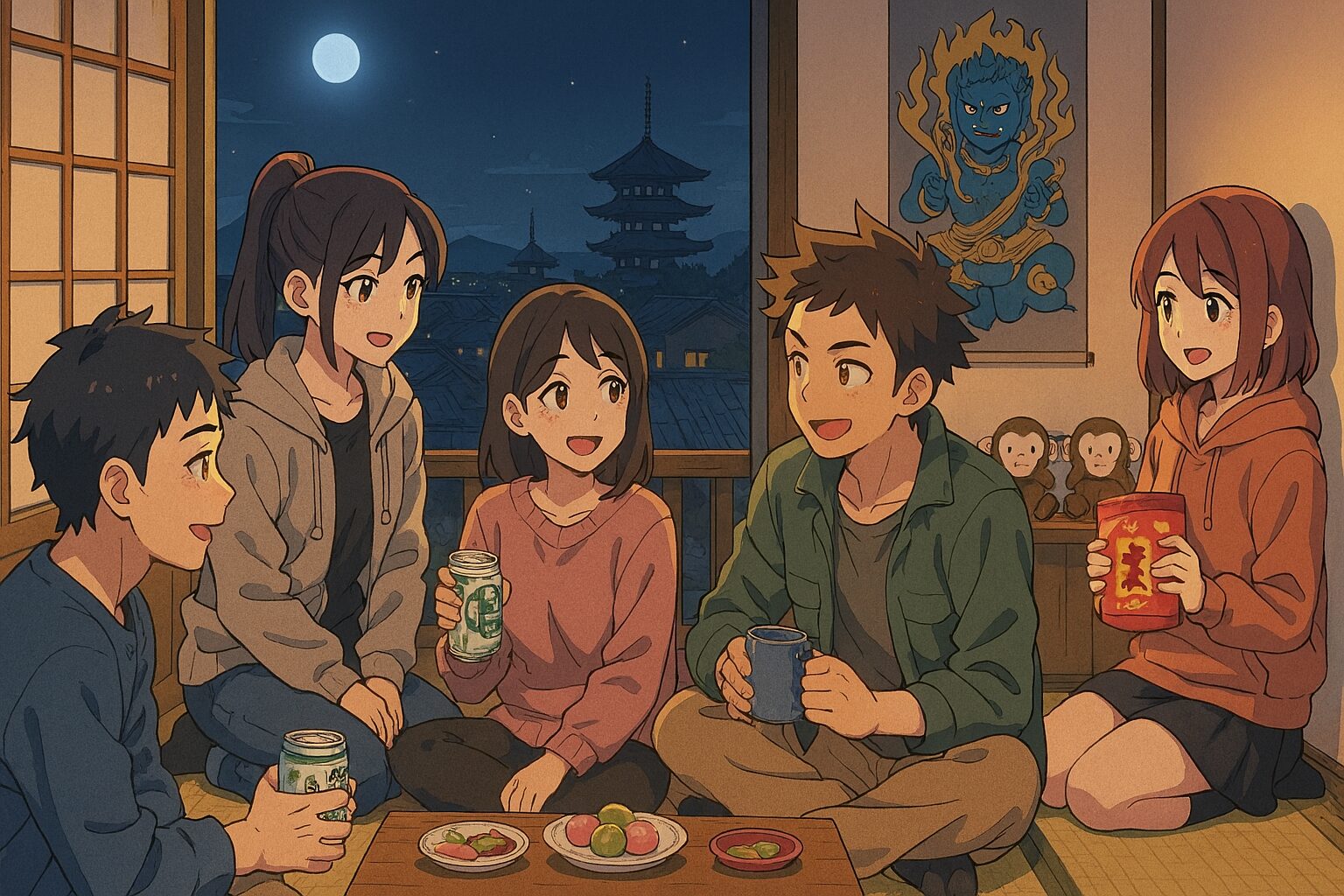Exploring Japan’s Depths: October 18th and the History Woven by Koshin Day
While October 18th in modern Japan is marked by practical observances like “Frozen Food Day” and “Statistics Day,” the date holds a deeper, more ancient significance rooted in the traditional calendar and beliefs. Today, we focus on what this day reveals about the core of Japanese culture if it aligned with the special zodiac day of Koshin (庚申, Kanoe-Saru).
Koshin is one of the 60 combinations in the Chinese zodiac cycle, recurring every 60 days. The meaning of this day transcends a mere chronological marker; it gave rise to the unique practice of “Koshin Belief” (Koshin Shinko), which is deeply rooted in Japan’s spiritual culture, folk religion, and the everyday life of its people.
① Koshin Belief: Does an All-Night Vigil Change Your Fate?
The Koshin Belief originated with the “Three Corpses Theory” (Sanshi-setsu) from Taoism, introduced to Japan during the Nara period. The Three Corpses (Sanshi) were three types of “evil worms” believed to reside within the human body. It was thought that on the night of Koshin Day, while the host slept, these worms would leave the body, ascend to the Heavenly Emperor (Tentei), and report the host’s sins. This accusation would result in the host’s lifespan being shortened—a terrifying prospect.
To avoid this fate, people devised a custom called Koshin-Machi (庚申待), or “Koshin Vigil.”
Staying Up All Night to Keep the “Worms” Locked In
On Koshin night, people would gather and stay awake until dawn. This practice was based on the belief that if the host did not sleep, the Three Corpses could not leave the body to report to the Heavenly Emperor. Starting among the aristocracy during the Heian period, it eventually spread to the common people, becoming immensely popular, especially in rural communities during the Edo period.
The Koshin-Machi gathering (Koshin-ko) was more than just an all-night watch. People enjoyed food and drink together, exchanging information and knowledge about farming techniques—making it a crucial community event. It served as a form of entertainment during a harsh life and fostered strong bonds as people prayed for each other’s safety and health.
Koshin Towers and the Three Monkeys: Traces of Faith
As a commemoration of holding these Koshin gatherings over several years, communities would erect a Koshin-to (庚申塔), or Koshin stone tower. These monuments were built to pray for longevity, health, family safety, and bountiful harvests. Koshin-to still stand today along old roads and village boundaries, testifying to the past fervor of the faith.
Engraved on many Koshin-to is the famous motif of the “Three Wise Monkeys” (三猿, San-en): “See no evil, Speak no evil, Hear no evil” (Mizaru, Iwazaru, Kikazaru). The word for the zodiac sign “Saru” (申) sounds like the word for “monkey” (猿), connecting the monkey as a messenger of the Koshin deity, Shomen Kongo. The Three Monkeys symbolize the importance of self-discipline and maintaining a pure heart by refraining from observing, speaking, or listening to wickedness.
② Connection to Japanese Culture: The Power of Faith-Driven Community
The most significant cultural connection derived from Koshin Day and the Koshin Belief is the formation and maintenance of community.
While Koshin-Machi began with the urgent desire to prolong life, it resulted in the creation of a strong organizational system known as a “Ko” (講), where people gathered, conversed, and supported one another regularly. This “Ko” system became the foundation for various other Japanese folk beliefs and social structures, including pilgrimages (like to Ise Grand Shrine) and mutual aid for life events.
The Boundary of “Hare” and “Ke”
The act of staying up all night, a truly extraordinary event, highlights the clear cultural distinction between “Hare (ハレ),” or the extraordinary/sacred, and “Ke (ケ),” or the ordinary/everyday. On a Hare day, people are liberated from daily constraints, rejuvenating their spirits and strengthening community bonds through special food, drink, and fellowship. Though rooted in Taoism, Koshin-Machi blended with Shinto and Buddhism, integrating completely into the Japanese way of life as a wisdom for creating “Hare” that transcended the daily “Ke.”
Koshin’s Traces in Modern Japan
Even today, centers of Koshin Belief, such as Yasaka Koshin-do (Kon-go-ji Temple) in Kyoto and Shitenno-ji Koshin-do in Osaka, attract many worshippers. Yasaka Koshin-do, famous for its colorful “Kukuri-Zaru” (tied-up monkeys), is a popular tourist spot, proving that the faith continues to live on in modern form. The “Kukuri-Zaru,” representing a monkey with its hands and feet bound, visualizes the teaching that if you suppress your desires and practice self-restraint, one wish will be granted. This beautifully connects to the Japanese spirit of “self-discipline” and “prudence.”
③ A Question for the Reader: What is Your “Koshin Vigil”?
The history of Koshin Belief demonstrates that people chose concrete action—cooperating with others and spending a night together—to achieve the universal desires of longevity and happiness. They sought to shape their personal destiny by supporting and protecting it within a community.
In modern society, we often try to solve problems solely through individual effort. But what if your life has its own “Three Corpses”—anxiety, stress, or loneliness? What would you do?
What is the “Koshin-Machi” of the modern age? It might be an all-night conversation with a loved one. It could be a meeting with colleagues who share a passion. Or perhaps it’s a quiet time of digital detox, listening to your inner voice.
After reading this article, **what do you choose to “wait” for to protect your own destiny and live a better life? With whom, and what kind of night, do you choose to spend?**
④ References and Related Links
- Meguro City: What is a Koshin-to? – Explanation of Koshin Belief and Koshin-to. (Japanese)
- Kiri53.com “What’s Today’s Special Day” Series – Internal link to the series on this blog.
日本の深層を探る:10月18日、庚申(かのえさる)の日が織りなす歴史と文化
10月18日は、現代日本において「冷凍食品の日」や「統計の日」といった実用的な記念日が制定されていますが、その背景には、太古から続く暦と信仰の奥深い流れが息づいています。今日、私たちが焦点を当てるのは、この日がもし旧暦や干支に基づき「庚申(かのえさる)」という特別な日と重なっていたとしたら、そこから読み解ける日本文化の深層です。
庚申は、暦の中でも60日に一度巡ってくる干支の一つです。この日が持つ意味は、単なる日付の符号を超え、日本の精神文化、民間信仰、そして庶民の生活様式に深く根差した「庚申信仰」というユニークな風習を生み出しました。
① 庚申信仰:徹夜が運命を変える?
庚申信仰は、奈良時代に中国から伝来した道教(タオイズム)の「三尸説(さんしせつ)」に端を発します。三尸(さんし)とは、人の体内に棲むとされる三種類の「悪い虫」のことで、彼らは宿主が眠っている庚申の日の夜に、体から抜け出して天帝(最高神)にその人の罪悪を告げ口しに行くと信じられていました。この告げ口の結果、その人の寿命が縮められるという恐ろしいものでした。
この運命を回避するために人々が編み出したのが、「庚申待(こうしんまち)」という風習です。
徹夜で「虫」を閉じ込める
庚申の日の夜、人々は集まって一晩中寝ずに過ごしました。これは、三尸の虫が活動できないように、つまり、宿主が眠らなければ体内から出て天帝に報告することができない、という考えに基づいています。平安時代の貴族社会で始まり、やがて庶民にも広がり、特に江戸時代には全国の農村で大流行しました。
庚申待の集会(庚申講)は、単なる徹夜会ではありませんでした。人々は共に飲食を楽しみ、さまざまな情報交換や農作業の知識・技術を学び合う、重要なコミュニティの場でもありました。これは、厳しい生活の中での娯楽であり、同時に互いの安全と健康を祈り合う、強い絆を生む行事だったのです。
庚申塔と三猿:信仰の痕跡
この庚申講を数年間にわたって続けた記念として、地域の人々は「庚申塔(こうしんとう)」を建立しました。これは、長寿や健康、家内安全、五穀豊穣などを祈願する石塔です。街道沿いや村の境目に今も残る庚申塔は、かつての信仰の隆盛を物語っています。
そして、多くの庚申塔に刻まれているのが、「見ざる、言わざる、聞かざる」で有名な「三猿(さんえん)」のモチーフです。干支の「申(さる)」が庚申の「猿(さる)」に通じるという語呂合わせと、神の使いとしての猿のイメージが結びつき、庚申の本尊である青面金剛(しょうめんこんごう)の従者とされました。この三猿の教えは、悪いことを見たり、言ったり、聞いたりしないことで、自身を律し、清らかな心でいることの大切さを象徴しています。
② 日本文化との関連性:信仰が生んだコミュニティの力
庚申の日、そして庚申信仰から読み解ける最も重要な日本文化との関連は、「コミュニティの形成と維持」です。
庚申待は、人々の生死に関わる切実な願いから始まったものですが、結果として、人々が定期的に集い、語り合い、助け合う「講(こう)」という組織を生み出しました。この「講」のシステムは、庚申信仰だけでなく、伊勢参りなどの巡礼、特定の神仏への参拝(○○講)、冠婚葬祭の互助組織など、日本のあらゆる民間信仰や社会生活の基盤となりました。
「ハレ」と「ケ」の境界
また、徹夜で語り明かすという非日常的な行為は、日本の文化概念における「ハレ(非日常)」と「ケ(日常)」の境界を明確にします。ハレの日には、日常の制約から解放され、特別な飲食や交流を通じて英気を養い、コミュニティの結束を強めます。庚申待は、道教由来でありながら、神道や仏教とも習合し、日本の風土に完全に溶け込み、日常の「ケ」を乗り越えて「ハレ」を創り出す知恵として機能したのです。
現代にも残る庚申の痕跡
現代の日本でも、京都の八坂庚申堂(金剛寺)や大阪の四天王寺庚申堂など、庚申信仰の中心地は今も多くの参拝者を集めています。特に、カラフルな「くくり猿」で知られる八坂庚申堂は、観光スポットとしても人気を博しており、信仰が形を変えて現代に生き続けている証拠です。猿が手足をくくられた姿の「くくり猿」は、欲望を抑え、一つだけ我慢すれば願いが叶うという教えを視覚化したものです。これは、日本人が大切にする「自己規律」と「慎み」の精神にも通じています。
③ 読者への問いかけ:あなたの「庚申待」とは?
庚申信仰は、人々が「長生きしたい」「幸せになりたい」という普遍的な願いを叶えるために、他者と協力し、一晩を共に過ごすという具体的な行動を選んだ歴史を示しています。彼らは、個人の運命を共同体の中で支え合い、守ることで切り開こうとしました。
現代社会では、私たちは個人の力で問題を解決しようとしがちです。しかし、もしあなたにとって、人生の「三尸の虫」——不安、ストレス、孤独——が存在するとしたら、どうしますか?
現代の「庚申待」とは、一体何でしょう。それは、大切な人と語り明かす夜かもしれません。情熱を共有する仲間とのミーティングかもしれません。あるいは、デジタルデトックスをして、自分自身の内なる声に耳を澄ます静かな時間かもしれません。
この記事を読んで、あなたは、**あなた自身の運命を守り、より良く生きるために、何を「待」ちますか? 誰と共に、どのような夜を過ごしたいと思いますか?**
④ 参考文献と関連リンク
- 目黒区 庚申塔(こうしんとう)って何 – 庚申信仰と庚申塔に関する解説(日本語)。
- Kiri53.com 「今日は何の日」シリーズ – 掲載ブログ内の関連シリーズへの内部リンク。



コメント